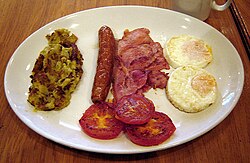Bubble and squeak
This article needs additional citations for verification. (January 2015) (Learn how and when to remove this template message) |
 A small portion of bubble and squeak (left), as part of an English breakfast | |
| Place of origin | United Kingdom |
|---|---|
| Main ingredients | Potatoes, cabbage, Brussels sprouts, vegetables |
Bubble and squeak is a traditional British breakfast dish made from potatoes and cabbage.
In modern times, it is a dish made with the shallow-fried Sunday leftover vegetables from a roast dinner. The main ingredients are potato and cabbage, but carrots, peas, sprouts, or any other leftover vegetables may be added. The chopped vegetables (and cold chopped meat, if used) are fried in a pan together with mashed potatoes or crushed roast potatoes until the mixture is well-cooked and brown on the sides. The dish is so named because the cabbage makes bubbling and squeaking sounds during the cooking process.[1] It is often served with cold meat from the Sunday roast and pickles or brown sauce, or as an accompaniment to a full English breakfast.
The meat was traditionally added to the bubble and squeak, although nowadays it is more commonly made without meat. The earliest-known recipe was in Mrs Rundell's A New System of Domestic Cookery in 1806.[2]
The name bubble and squeak is used primarily in England (for Scotland and Ireland[3] see the section Similar dishes), and it may also be understood in parts of some other Commonwealth countries and the United States.[4][5]
Bubble and squeak has been a popular dish since the late 1800s, as it was an easy way of using leftovers. In more recent times, ready-made pre-prepared versions have become available on the market.
Similar dishes[edit]
- Panackelty, from North East England
- Rumbledethumps, stovies and clapshot from Scotland
- Colcannon and champ, from Ireland
- Stoemp from Belgium
- Calentao, from Colombia
- Biksemad, from Denmark
- Stemmelkort, from Germany
- Stamppot, from the Netherlands
- Trinxat, from the La Cerdanya region of Catalonia, northeast Spain and Andorra
- Pyttipanna, Pyttipanne and Pyttipannu (from the Swedish "pytt i panna"="small pieces in pan") from Sweden, Norway and Finland
- Hash, from the United States
- Aloo tikki, from India
- Matevž, from Slovenia
- Tortilla de verduras, from Chile[citation needed]
- Fry up (from Wales)
References[edit]
- ^ Pickett, Joseph P.; et al. (2000), American Heritage Dictionary of the English Language, Houghton Mifflin.
- ^ Rundell, Maria Eliza Ketelby (1808). Bubble and Squeak. In A new system of domestic cookery:Third edition. p. 42. Google Book Search. Retrieved on 6 January 2011.
- ^ In Canada where the term may have originated, it usually refers strictly to a dish of the leftovers of a cottage roll dinner. Scottish Recipes: Rumbledethumps Recipe
- ^ Hearty Luncheon and Supper Dishes Reading Eagle, 17 July 1913.
- ^ Forbes Lifestyle, Wine and Food Forbes, 17 November 2004.
External links[edit]
 Media related to Bubble and squeak at Wikimedia Commons
Media related to Bubble and squeak at Wikimedia Commons
| Wikibooks Cookbook has a recipe/module on |

No comments:
Post a Comment